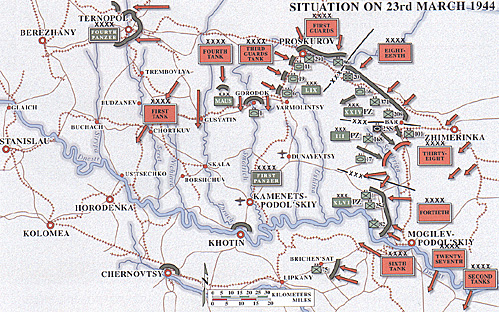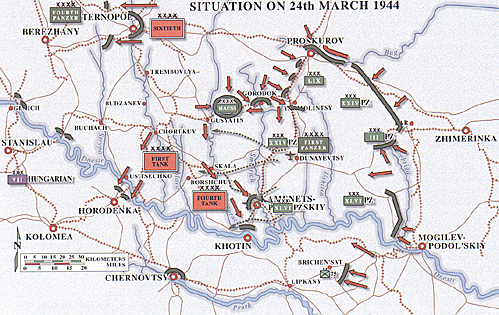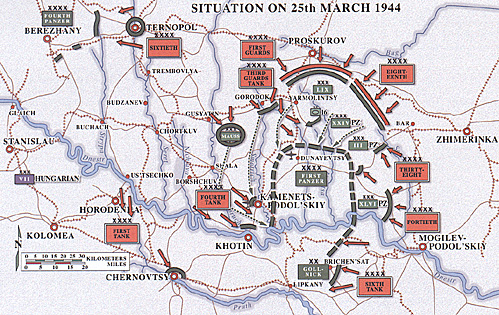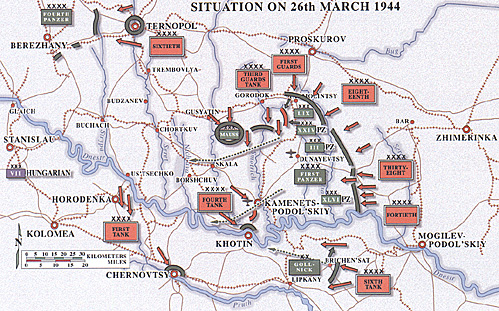 Manstein finally ordered Hube to attack
westwards with his infantry units acting as
rearguards while the panzers rode gunpoint.
Hube at once began to evacuate all non-combat
units south across his only route the pontoon
bridge at Khotin.
Manstein finally ordered Hube to attack
westwards with his infantry units acting as
rearguards while the panzers rode gunpoint.
Hube at once began to evacuate all non-combat
units south across his only route the pontoon
bridge at Khotin.
The net effect of this
operation was to act as a magnet on the
Soviets. Based on observations of the
evacuation, STAVKA was convinced Hube
would try to escape south into Rumania so
more and more Soviet formations moved
southward. This strategic deception proved
most beneficial to the German plans in the end.
 The Germans began their breakout
attack to the west with a failure as the isolated
1st Panzer Division remained so due to heavy
Soviet pressure. Group Mauss and the 1st
Panzer Division were in fact forced back from
the key road leading from Yampol to Gus.
Now, Hube contacted Manstein and re-requested permission to abandon the mass
breakout to the west and instead try to
infiltrate small groups out to the west or south.
The Germans began their breakout
attack to the west with a failure as the isolated
1st Panzer Division remained so due to heavy
Soviet pressure. Group Mauss and the 1st
Panzer Division were in fact forced back from
the key road leading from Yampol to Gus.
Now, Hube contacted Manstein and re-requested permission to abandon the mass
breakout to the west and instead try to
infiltrate small groups out to the west or south.
The operational names for these small group breakout plans were OPERATION LETTOW-VORBECK, which was the plan to go to the south into Rumania, and OPERATION MACKENSEN, the plan to move westward. Without waiting for a reply, Hube rescinded the order for the mass breakout to the west and began plans to escape south (LETTOW-VORBECK).
Group Mauss, which had been elbowed southward, was east of the Zbrucz River by this time and to the left of this formation there were no German soldiers.
On March 26th, Manstein, perturbed, laconically issued a stronger order: "Solution west! Orders follow". He saw that if Hube's plan to breakout in small groups were permitted, First Panzer Army would cease to exist as an organized fighting force. The resulting hole in the line would dwarf the catastrophe of Stalingrad! Instead Manstein directed that the mass breakout to the west would continue.
 The flanks of First Panzer Army were to
be protected west of Gorodok along the
Dshitoa River, and the Soviet held road
between Kamenets to Khotin was to be retaken.
The flanks of First Panzer Army were to
be protected west of Gorodok along the
Dshitoa River, and the Soviet held road
between Kamenets to Khotin was to be retaken.
Hube again rescinded his orders authorizing the southern breakout. To facilitate command and control of the breakout, Hube developed a "Corps Group" concept. Each "Corps Group" would actually be composed of several corps. Corps Group "Chevallerie" was composed of LIX Corps, XXIV Panzer Corps, and Group "Mauss" totaling some 14 divisions. Corps Group "Brieth" contained the III and YCLVI Panzer Corps with 8 divisions plus Group "Golinick" with 3 divisions.
As you can see, First Panzer Army was actually two small armies on the move! Hube ordered CG Chevallerie to establish a bridgehead at Skala. CG Breith was to retake the city of Kamenets, clear the road and move to establish a bridgehead across the Zbruch River northeast of Khotin. Group "Golinick" was to conduct a withdrawal to Khotin and cross the Dnestr there, joining up with CG Breith north of the river.
 It was around this time that the first air
supplies missions arrived, flown in by five
groups of the 2nd Air Tranport Section of the
4th Air Fleet at Lvov, Poland. Most supplies
were transported in Ju 52s and He 111 planes.
Interestingly, no food rations were flown in,
only weapons and ammo, and the German
soldiers were instructed to "procure from local
sources". The air force was also instructed not
to bomb any bridges west of Mogliev.
It was around this time that the first air
supplies missions arrived, flown in by five
groups of the 2nd Air Tranport Section of the
4th Air Fleet at Lvov, Poland. Most supplies
were transported in Ju 52s and He 111 planes.
Interestingly, no food rations were flown in,
only weapons and ammo, and the German
soldiers were instructed to "procure from local
sources". The air force was also instructed not
to bomb any bridges west of Mogliev.
Kesselschlacht March-April 1944
- Introduction and Background
Terrain and Weather
The Deception
The Battle Begins
Breakout
Aftermath
The Face of Battle
All Daily Situation Maps (monstrously slow: 1.646Mb!)
Back to Table of Contents -- Against the Odds vol. 1 no. 3
Back to Against the Odds List of Issues
Back to MagWeb Magazine List
© Copyright 2002 by LPS.
This article appears in MagWeb.com (Magazine Web) on the Internet World Wide Web.
Other articles from military history and related magazines are available at http://www.magweb.com
* Buy this back issue or subscribe to Against the Odds direct from LPS.
